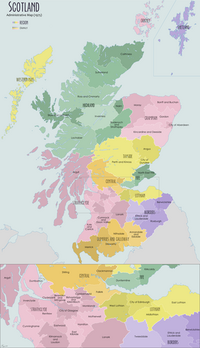Scottish Borders
Template:Infobox Scotland council area
The Scottish Borders, often referred to simply as the Borders, is one of 32 local government council areas of Scotland.[1] It is bordered by Dumfries and Galloway in the west, South Lanarkshire and West Lothian in the north west, City of Edinburgh, East Lothian, Midlothian to the north; and the non-metropolitan counties of Northumberland and Cumbria in England to the south and east. The administrative centre of the area is Newtown St. Boswells.
The area was created in 1975, by merging the former counties of Berwickshire, Peeblesshire, Roxburghshire and Selkirkshire and part of Midlothian, as a two-tier region with the districts of Berwickshire, Ettrick and Lauderdale, Roxburgh, and Tweeddale within it. In 1996 the region became a unitary authority area and the districts were wound up. The region was created with the name Borders. Following the election of a shadow area council in 1995 the name was changed to Scottish Borders with effect from 1996.[2]
Geography
The Scottish Borders are located in the Eastern part of the Southern Uplands. [1]
The region is hilly, with the River Tweed flowing west to east through the region. In the east of the region the area that borders the River Tweed is flat and is known as 'The Merse'. The Tweed and its tributaries drain the entire region with the river flowing into the North Sea at Berwick-upon-Tweed, and forming the border with England for the last twenty miles or so of its length.
The term Central Borders refers to the area in which the majority of the main towns of Galashiels, Selkirk, Hawick, Jedburgh, Earlston, Kelso, St Boswells, Newtown St Boswells, Melrose and Tweedbank are located.
History
Historically, the term Borders has a wider meaning, referring to all of the burghs adjoining the English border, also including Dumfriesshire and Kirkcudbrightshire — as well as Northumberland, Cumberland and Westmorland in England.
Roxburghshire and Berwickshire historically bore the brunt of the conflicts with England, both during declared wars such as the Wars of Scottish Independence, and armed raids which took place in the times of the Border Reivers. Thus, across the region are to be seen the ruins of many castles, abbeys and even towns.
The people of the Scottish Borders are very proud of their heritage and often speak of themselves as Borderers.
Although there is evidence of some Scottish Gaelic in the origins of place names such as Innerleithen ("confluence of the Leithen"), Kilbucho, and Auchencrow, which contain identifiably Goidelic rather than Brythonic Celtic elements, the language has tended to be weak to non-existent in most parts of the region. Since the 5th century, there has been evidence of two main languages in the area: Brythonic and Old English, the latter of which developed into its modern forms of English and Scots.
Transport
The region has no working railway stations. Although the area was well connected to the Victorian railway system, the branch lines that supplied it were closed in the decades following the Second World War. A bill has been passed by the Scottish Parliament to extend the Waverley Line, which would be a commuter service from Edinburgh to Stow, Galashiels and Tweedbank. Today, the East Coast Main Line is the only railway which runs through the region, with Edinburgh Waverley, Berwick-upon-Tweed and Carlisle being the nearest stations.
The area is served by buses which connect the main population centres. Express bus services link the main towns with rail stations at Edinburgh and Carlisle.
The region also has no commercial airports; the nearest are Edinburgh and Newcastle, both of which are international airports.
The main roads to and from the region are:
- The A1, which runs along the east coast from London to Edinburgh; passing near Eyemouth.
- The A7 which runs north to south from Edinburgh to Carlisle and the M6; passing through Galashiels, Selkirk and Hawick.
- The A68 running from Darlington to Edinburgh; passing through Jedburgh, Newtown St. Boswells, Earlston and Lauder.
- The A72, which runs east to west from Galashiels to Biggar; passing through Innerleithen and Peebles
Towns and villages

- Abbey St. Bathans, Allanton, Ashkirk
- Broughton, Burnmouth
- Cardrona, Chirnside, Clovenfords, Cockburnspath, Coldingham, Coldstream
- Denholm, Dryburgh, Duns
- Earlston, Eddleston, Ettrick, Ettrickbridge, Eyemouth
- Foulden
- Galashiels, Greenlaw
- Hawick
- Innerleithen
- Jedburgh
- Kelso, Kirk Yetholm
- Lauder, Lilliesleaf, Longformacus
- Melrose
- Newcastleton, Newstead, Newtown St. Boswells
- Peebles
- Roxburgh
- Selkirk, St. Abbs, St Boswells, Stow, Stichill
- Teviothead, Town Yetholm, Traquair
- Walkerburn, West Linton
Places of interest
- Abbotsford House
- Bowhill House
- Cheviot Hills
- Cessford Burn
- Dawyck Botanic Gardens
- Dryburgh Abbey - Historic Scotland
- Duns Castle
- Edin's Hall Broch
- Ettrick Forest
- Eyemouth Museum
- Floors Castle
- Glentress Forest - Forest Enterprise
- Greenknowe Tower
- Harmony Garden - National Trust for Scotland
- Hawkshaw - ancestral home of the Porteous family
- Hermitage Castle - Historic Scotland
- Jedburgh Abbey - Historic Scotland
- Kailzie Gardens
- Kelso Abbey
- Lammermuir
- Lauderdale, Scotland
- Manderston
- Megget Reservoir
- Mellerstain House
- Melrose Abbey - Historic Scotland
- Monteviot House
- Neidpath Castle
- Nisbet, Berwickshire
- Nisbet, Roxburghshire
- Paxton House
- Pennine Way - National Trails
- Priorwood Garden - National Trust for Scotland
- Robet Smail's Printing Works - National Trust for Scotland
- Smailholm Tower - Historic Scotland
- Southern Upland Way - National Trails
- St. Abbs Head
- St. Mary's Loch
- St. Ronans Wells
- Teviotdale
- Thirlestane Castle
- Traquair House
- Trimontium
- Waterloo Monument
- Wedderburn Castle
Notes and references
- ^ Local councils of Scotland, Directgov website
- ^ Notice of change of name of local authority area, Edinburgh Gazette, 26 May 1995

